Kerala Plus Two Microeconomics Chapter Wise Previous Questions Chapter 6 Non-Competitive Markets
Question 1.
a) Draw the demand curves of perfect competition and monopoly market situations. (MARCH-2008)
b) Give reasons for the different shapes of demand curves in these markets?
Answer:
a) Demand curve of firm in perfect competition will be a horizontal straight line and that of monopoly will be a downward sloping. It is drawn below.
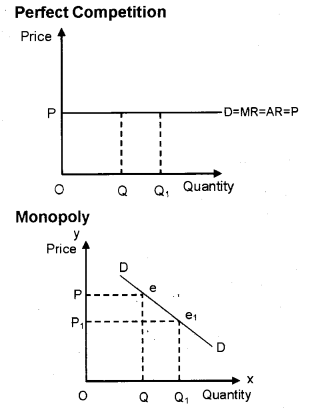
b) In perfect competition demand curve is horizontal because the price for every unit sale will be uniform. In monopoly, price varies for every unit of output. Therefore demand curve slopes downward.
Question 2.
From your experience identify two examples each for the following market forms: (MARCH-2008)
a) Monopoly
b) Monopolistic competition
Answer:
Monopoly
KSEB
Indian Railway
Monopolistic competition
Soap industry
Toothpaste industry
Question 3.
State whether the following statements are correct or false. Give justification for your answer. (MARCH-2009)
1) Price discrimination is an important feature of perfect competition.
2) Selling cost is the cost for producing the commodity.
3) Product differentiation is one of the main features of Monopoly.
4) Price leadership is an important feature of Oligopoly.
Answer:
1) False
2) False
3) False
4) True
Question 4.
Write the correct market form in which the following firms operate. (MARCH-2009)

Answer:
KSEB – Monopoly
Reliance – Communication Ltd. Oligopoly
Question 5.
Pick up the odd one and justify your answer. (MARCH-2009)
a) Monopolistic competition
b) Oligopoly
c) Monopsony
d) Perfect competition
Answer:
Monopsony
Question 6.
From the data given in table find TR and AR. Write any two relation between TR and MR. (MARCH-2009)
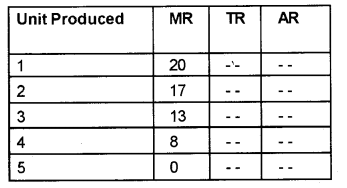
Answer:
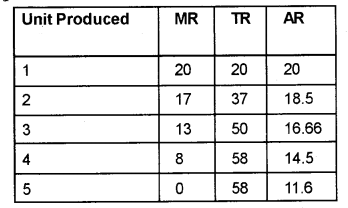
When TR is maximum, MR becomes zero.
When TR reduces, MR becomes negative.
Question 7.
Fill up the following table appropriately: (MARCH-2009)
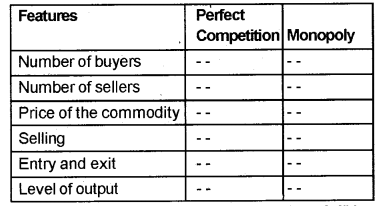
Answer:
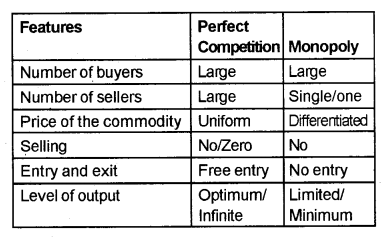
Question 8.
The average revenue curves of two market situations are given below: (MAY-2009)
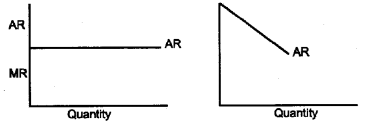
Draw MR curves corresponding to AR curves.
State the market situation corresponding to AR curves.
Give reasons for difference in AR and MR between two market forms.
Answer:
a)

b) First curve is related to perfect competition. Second curve is related to monopoly.
c) In perfect competition AR and MR are equal because every unit of the product is called sold at uniform price. Whereas, in monopoly firm can sell more only at lower prices. Therefore, different units are sold at different prices. This leads to difference in AR and MR curves.
Question 9.
Output and average revenue of firm are given below.
Fill up the missing columns and write the relevant equation of TR and MR : (MAY-2009)

Answer:

Question 10.
State whether the following statements are true or false. Rewrite if they are wrong: (MAY-2009)
a) The products in perfect competitive market are homogenous.
b) Seller in monopoly is a price taker.
c) Price leadership is an important feature of monopolistic competition.
d) Selling cost is a feature of monopoly.
e) Price discrimination under monopoly is always profitable.
1) Market in which there is only one buyer is called duopoly.
Answer:
True
b) False – price maker
c) False – a feature of Oligopoly
d) False – a feature of monopolistic competition
e) True
f) False – called monopsony
Question 11.
The average revenue curve of two market situation are given below: (MARCH-2010)
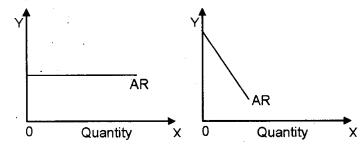
a) State the market situation corresponding to AR curves.
b) Give reasons for the different shapes.
c) Draw MR curves corresponding to AR curves.
Answer:
a) Perfect competition, monopoly
b) Under perfect competition, firm is price taker, therefore, AR = MR
Under monopoly, firm is price maker, therefore, AR > MR
c)
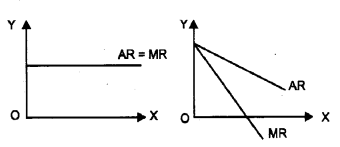
Question 12.
The main objective of the monopoly firm is profit maximisation. State the profit maximisation condition of a monopolist firm. (MARCH-2010)
Answer:
A monopolist maximises profit at that level of output for which the MC = MR and MC is rising. In other words, monopolist maximises profit at that level of output for which the vertical difference between TR and TC is maximum and TR is above the TC. In this level, the firm produces half of the market demand.
Question 13.
The following table shows the total cost schedule of a competitive firm. It is given that the price of the good is ₹15 (MARCH-2010)
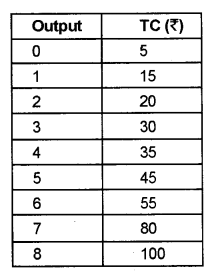
a) Calculate profit at each level of output.
b) Find the profit maximising level of output.
Answer:
a)
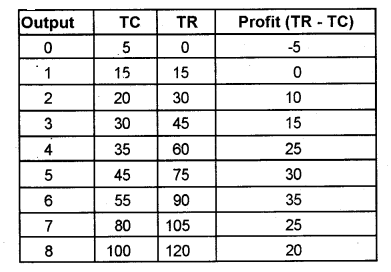
b) The profit maximising level of outputs is 6, where the difference between TR and TC is highest.
Question 14.
Which of the following is a characteristic of oligopoly? (MARCH-2013)
i) A market situation with only a few buyers
ii) A market situation with only a few sellers
iii) A market situation with only one seller
iv) Government control overprice.
Answer:
ii) A market situation with only a few sellers
Question 15.
Which type of market have full control over price? (MARCH-2013)
i) Perfect competition
ii) Monopolistic competition
iii) Monopoly
iv) Oligopoly
Answer:
iii) Monopoly
Question 16.
Can you explain why the demand curve facing a firm under monopolistic competition is negatively sloped? (MAY-2014)
Answer:
Monopolistic competition

The demand curve under monopolistic competition is neither perfectly elastic nor elastic but more elastic then monopoly. This is basically beacuse, close substitutes are available in monopolistic competition but not in monopoly.
Monopolistically competitive firms maximize their profit when they produce at a level where its marginal costs equals its marginal revenues. Because the individual firm’s demand curve is downward sloping, reflecting market power, the price these firms will charge will exceed their marginal costs. Due to how products are priced in this market, consumer surplus decreases below the pare to optimal levels you would find in a perfectly competitive market, at least in the short run. As a result, the market will suffer dead weight loss. The suppliers in this market will also have excess production capacity.
Question 17.
Monopolistic competition consists of: (MAY-2015)
a) A few firms selling identical products.
b) A few firms selling differentiated products.
c) Large number of firms selling identical products.
d) Large number of firms selling differentiated products.
Answer:
d) Large number of firms selling differentiated products
Question 18.
Which of the following describes monopoly? (MAY-2015)
a) Large number of buyers
b) Large number of sellers
c) Only a single buyer
d) Only a single seller with complete control over industry.
Answer:
Only a single seller with complete control over industry.
Question 19.
Linder Oligopoly the output decision of any one firm necessarily affect the price and quantity sold by other firms. Hence the rivals may react to protect the profit. List the three different ways in which oligopoly firms may behave. (MAY-2015)
Answer:
If the market of a particular commodity consists of more than one seller but the number of sellers is few, the market structure is termed oligopoly. The special case of oligopoly where there are exactly two sellers is termed duopoly. We shall explain the different ways in which the oligopoly firms may behave.
- Firstly duopoly firms may collude together and decide not to compete with each other and maximize total profits of the two firms together. In such a case the two firms would behave like a single monopoly firm that has two different factories producing the commodity.
- Secondly, take the case of a duopoly where each of the two firms decide how much quantity to produce by maximizing its own profit assuming that the other firm would not change the quantity that it is supplying. We can examine the impact using a simple example where both the firms have zero cost.
- Thirdly, some economists argue that oligopoly market structure makes the market price of the commodity rigid, i.e., the market price does not move freely in response to changes in demand.
Question 20.
From the schedule given below, calculate the Total Revenue (TR) and derive the demand schedule. (MARCH-2016)

Answer:

Question 21.
The demand curve faced by a firm under monopolistic competition is negatively sloped. Explain. (MARCH-2016)
Answer:
The demand curve faced by a firm under monopolistic competition is negatively sloped because a firm under monopolistic competition could sell more of the commodity only by reducing the price.
Question 22.
What do you mean by monopoly market? Explain the features of monopoly. Also explain the short run equilibrium of a monopoly producer. (MAY-2016)
Answer:
Monopoly may be defined as a market situation in which there is only a single seller. He controls the entire market. The term monopoly has derived from two Greek words such as ‘mono’ means single and poly means ‘seller’. The meaning of the combined term is single seller. In a boarder sense, a monopolist is single seller of a commodity which does not have close substitutes. E.g. KSEB Features of Monopoly Market Some of the salient features of monopoly are as follows:
1) There is only a single firm producing the product
2) There is no close substitute for the product
3) Entry is denied for other producers
4) Since there is only one seller, the firm and the industry are same
5) The firm under monopoly is the price maker
Question 23.
Oligopoly is a market situation in which there is only (MAY-2016)
a) a few buyers
b) one seller
c) a few sellers
d) large number of sellers
Answer:
c) A few sellers
Question 24.
Why the Average Revenue Curve and Marginal Revenue Curve of a firm under monopolistic competition is negatively sloped? (MARCH-2017)
Answer:
The demand curve under monopolistic competition is much flatter, i.e, the demand curve of monopolistic competition is more price elastic, which can be explained with diagram.

Question 25.
Examine the diagram given below. Identify the mistake and redraw the diagram. What is the relation between Total Revenue and Marginal Revenue as the firm expands its output? (MARCH-2017)

Answer:
Relation between TR and MR
As more and more units of output is sold the TR increases at a decreasing rate MR decreases. When TR reaches maximum MR is zero.
When TR decreases MR is negative.

